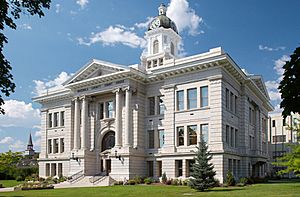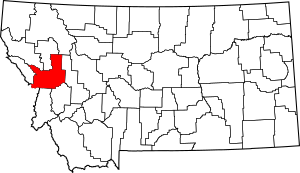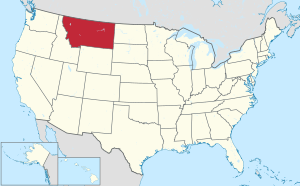Missoula County, Montana facts for kids
Quick facts for kids
Missoula County
|
|
|---|---|

Missoula County Courthouse
|
|

Location within the U.S. state of Montana
|
|
 Montana's location within the U.S. |
|
| Country | |
| State | |
| Founded | December 14, 1860 |
| Seat | Missoula |
| Largest city | Missoula |
| Area | |
| • Total | 2,618 sq mi (6,780 km2) |
| • Land | 2,593 sq mi (6,720 km2) |
| • Water | 25 sq mi (60 km2) 1.0% |
| Population
(2020)
|
|
| • Total | 117,922 |
| • Estimate
(2022)
|
121,041 |
| • Density | 45.043/sq mi (17.391/km2) |
| Time zone | UTC−7 (Mountain) |
| • Summer (DST) | UTC−6 (MDT) |
| Congressional district | 1st |
|
|
Missoula County is a county in the state of Montana. It's a place where many people live, work, and go to school. In 2020, about 117,922 people called Missoula County home. This makes it the third largest county in Montana by population.
The main city and county seat (the place where the county government is) is Missoula. The county was officially started in 1860. Missoula County is also part of the larger Missoula, MT Metropolitan Statistical Area.
Contents
Exploring Missoula County's Past
Missoula County has a long and interesting history. It was first set up in 1860. Back then, it was part of the Washington Territory. The county was much bigger than it is today. It included parts of what are now other counties in Montana.
How Missoula County Grew
The land that is now Missoula County became part of the United States in 1846. This happened because of a special agreement called the Oregon Treaty. At first, it was part of Oregon Territory and then the Washington Territory.
Over the years, the county's size changed many times. New counties were created from its land. For example, in 1863, it became the third county in the new Idaho Territory. The county seat moved to a place called Wordensville, which is now the city of Missoula.
Becoming Part of Montana
In 1864, Missoula County became part of the brand new Montana Territory. More counties were formed from its land over the next few decades. This included Flathead, Ravalli, and Lake counties. By 1923, Missoula County had its current borders.
Discovering Missoula County's Geography
Missoula County covers a total area of about 2,618 square miles (6,780 square kilometers). Most of this is land, with a small amount of water. It's the 24th largest county in Montana.
Mountains, Valleys, and Rivers
This area is very mountainous. It has five large valleys and two main rivers. These rivers are the Clark Fork and the Bitterroot Rivers. They wind through the beautiful landscape.
Animals and Plants of Missoula County
Missoula County is in the Rocky Mountains. This means it has many types of animals and plants typical of this region.
Wildlife in the Rockies
You can find many animals here. These include white-tailed deer, black bears, osprey, and bald eagles. In winter, elk and mule deer often graze on Mount Jumbo. This is because the snow melts quickly on its steep slopes.
The rivers are home to many birds like bank swallows and belted kingfishers. You might also see Killdeer and spotted sandpipers looking for insects. Other birds include song sparrows and pileated woodpeckers. The rivers also have fish like westslope cutthroat trout and bull trout. Beaver and wood ducks also enjoy the winding streams.
Plants and Trees
The plants along the rivers include willows and cottonwoods. Montana's state tree, the ponderosa pine, also grows here. Other native plants are cattails and beaked-sedge. You can also find shrubs like Douglas hawthorn and chokecherry.
Some plants, called noxious weeds, are not native and can cause problems. Programs are working to remove them.
Missoula County's Climate
Missoula County has a semi-arid climate. This means it's usually dry, but not a desert. Winters are cold and have some snow. Summers are hot and dry. Spring and autumn are short and cool.
Winter weather is often milder here than in other parts of Montana. This is because of its location in the western part of the state. It also gets more moisture in winter than many other areas. Snowfall averages about 43 inches (109 cm) each year.
Summers are very sunny. Temperatures often reach 84°F (29°C) in July. The difference between day and night temperatures is large, especially from April to October. This is due to the dry air.
| Climate data for Missoula, Montana (Missoula Airport) | |||||||||||||
|---|---|---|---|---|---|---|---|---|---|---|---|---|---|
| Month | Jan | Feb | Mar | Apr | May | Jun | Jul | Aug | Sep | Oct | Nov | Dec | Year |
| Record high °F (°C) | 60 (16) |
66 (19) |
78 (26) |
90 (32) |
95 (35) |
102 (39) |
107 (42) |
105 (41) |
99 (37) |
85 (29) |
73 (23) |
60 (16) |
107 (42) |
| Mean daily maximum °F (°C) | 33.2 (0.7) |
38.8 (3.8) |
49.8 (9.9) |
58.5 (14.7) |
67.3 (19.6) |
75.2 (24.0) |
85.9 (29.9) |
84.9 (29.4) |
73.1 (22.8) |
57.8 (14.3) |
41.5 (5.3) |
31.0 (−0.6) |
58.2 (14.6) |
| Mean daily minimum °F (°C) | 18.3 (−7.6) |
21.2 (−6.0) |
27.7 (−2.4) |
32.8 (0.4) |
39.8 (4.3) |
46.6 (8.1) |
51.4 (10.8) |
50.1 (10.1) |
41.8 (5.4) |
32.4 (0.2) |
24.9 (−3.9) |
16.7 (−8.5) |
33.7 (0.9) |
| Record low °F (°C) | −33 (−36) |
−28 (−33) |
−13 (−25) |
2 (−17) |
21 (−6) |
26 (−3) |
31 (−1) |
29 (−2) |
15 (−9) |
−4 (−20) |
−23 (−31) |
−30 (−34) |
−33 (−36) |
| Average precipitation inches (mm) | 0.85 (22) |
0.70 (18) |
1.00 (25) |
1.22 (31) |
2.01 (51) |
2.07 (53) |
0.99 (25) |
1.19 (30) |
1.17 (30) |
0.88 (22) |
1.01 (26) |
1.04 (26) |
14.13 (359) |
| Average snowfall inches (cm) | 8.3 (21) |
6.1 (15) |
5.1 (13) |
1.2 (3.0) |
0.2 (0.51) |
— | 0.0 (0.0) |
0.0 (0.0) |
— | 0.6 (1.5) |
5.4 (14) |
11.0 (28) |
37.9 (96) |
| Average precipitation days (≥ 0.01 in) | 11.8 | 9.4 | 11.4 | 11.1 | 12.3 | 12.1 | 7.1 | 7.5 | 8.2 | 8.4 | 11.1 | 12.3 | 122.7 |
| Average snowy days (≥ 0.1 in) | 9.4 | 6.8 | 5.1 | 1.6 | 0.3 | 0.1 | 0.0 | 0.0 | 0.0 | 0.9 | 5.4 | 9.8 | 39.4 |
| Average relative humidity (%) | 81.3 | 78.1 | 70.3 | 61.2 | 61.7 | 61.1 | 51.7 | 52.5 | 62.8 | 70.8 | 80.2 | 83.5 | 67.9 |
| Mean monthly sunshine hours | 95.8 | 133.0 | 209.3 | 245.0 | 280.5 | 311.1 | 389.3 | 334.8 | 264.7 | 194.3 | 99.5 | 82.9 | 2,640.2 |
| Percent possible sunshine | 34 | 46 | 57 | 60 | 60 | 66 | 81 | 76 | 70 | 58 | 35 | 31 | 59 |
| Source: NOAA (normals 1981−2010, relative humidity and sun 1961–1990) | |||||||||||||
Protected Natural Areas
Missoula County is home to parts of several national forests. These areas help protect nature and offer places for outdoor activities.
- Bitterroot National Forest (part)
- Flathead National Forest (part)
- Lolo National Forest (part)
- Rattlesnake National Recreation Area
Major Roads and Transportation
Several important highways run through Missoula County. These roads connect communities and help people travel.
Public transportation options are also available.
- Jefferson Lines
- Mountain Line
Neighboring Counties
Missoula County shares its borders with several other counties.
- Mineral County - west
- Sanders County - northwest
- Lake County - north
- Flathead County - northeast
- Powell County - east
- Granite County - southeast
- Ravalli County - south
- Idaho County, Idaho - southwest
- Clearwater County, Idaho - southwest
People of Missoula County
The number of people living in Missoula County has grown a lot over the years.
| Historical population | |||
|---|---|---|---|
| Census | Pop. | %± | |
| 1870 | 2,554 | — | |
| 1880 | 2,537 | −0.7% | |
| 1890 | 14,427 | 468.7% | |
| 1900 | 13,964 | −3.2% | |
| 1910 | 23,596 | 69.0% | |
| 1920 | 24,041 | 1.9% | |
| 1930 | 21,782 | −9.4% | |
| 1940 | 29,038 | 33.3% | |
| 1950 | 35,493 | 22.2% | |
| 1960 | 44,663 | 25.8% | |
| 1970 | 58,263 | 30.5% | |
| 1980 | 76,016 | 30.5% | |
| 1990 | 78,687 | 3.5% | |
| 2000 | 95,802 | 21.8% | |
| 2010 | 109,426 | 14.2% | |
| 2020 | 117,922 | 7.8% | |
| 2022 (est.) | 121,041 | 10.6% | |
| U.S. Decennial Census 1790–1960, 1900–1990, 1990–2000, 2010–2020 |
|||
Population in 2020
In 2020, the census counted 117,922 people living in Missoula County.
Population in 2010
The 2010 census showed 109,299 people lived here. The county had about 42 people per square mile. Most residents were white (92.7%). There were also people of American Indian (2.6%), Asian (1.1%), and Black or African American (0.4%) backgrounds. About 2.6% of the population was of Hispanic or Latino origin.
Many people in Missoula County have ancestors from different parts of the world. The largest groups reported German (26.1%), Irish (17.8%), and English (12.3%) heritage.
Missoula County's Economy
Missoula County has a strong and varied economy. It's a growing center for trade in the region. Many people work for large employers. These include the University of Montana, local hospitals, and the U.S. Forest Service. Each of these employs thousands of people.
However, most workers (90%) are employed by small businesses. These are businesses with fewer than 20 employees. About a quarter of the workers in the county are self-employed.
Learning in Missoula County
Missoula County has many schools and colleges.
School Districts
There are 18 school districts in Missoula County. This includes 13 elementary school districts, 2 high school districts, and 3 districts that cover all grades (K-12).
K-12 (Unified) Districts
These schools teach students from kindergarten through 12th grade.
- Alberton K-12 Schools
- Florence-Carlton K-12 Schools
- Frenchtown K-12 Schools
High School Districts
These districts focus on high school education.
- Arlee High School District
- Missoula High School District
Elementary School Districts
These districts provide education for younger students.
- Arlee
- Bonner
- Clinton
- DeSmet
- Hellgate
- Lolo
- Missoula
- Potomac
- Seeley Lake
- Sunset
- Swan Valley
- Target Range
- Woodman
Colleges and Universities
For students who want to continue their education after high school, Missoula County offers:
- University of Montana
- Missoula College - University of Montana
Communities of Missoula County
Missoula County has one main city and many smaller towns and communities.
City
- Missoula (the county seat)
Census-Designated Places
These are areas that are like towns but are not officially incorporated as cities.
- Bonner-West Riverside
- Carlton
- Clinton
- Condon
- East Missoula
- Evaro
- Frenchtown
- Huson
- Lolo
- Orchard Homes
- Piltzville
- Potomac
- Seeley Lake
- Turah
- Twin Creeks
- Wye
Other Unincorporated Communities
These are smaller communities that are not officially part of a city or census-designated place.
- Clearwater
- Coloma
- Greenough
- Hell Gate
- Lolo Hot Springs
- Lothrop
- Milltown
- Nagos
- Ninemile
- Sunset
- Westview Park
- Yreka
See also
 In Spanish: Condado de Missoula para niños
In Spanish: Condado de Missoula para niños

